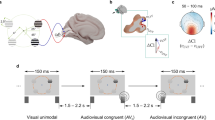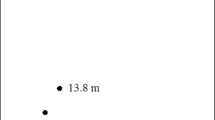Abstract
Some blind people are better at locating sounds than people with normal vision indicating cross-modal plasticity. People who have lost one eye have a unique form of visual deprivation that reduces visual afferent signals by half and can potentially also lead to cross-modal (as well as intra-modal) plasticity. To look for evidence of auditory-visual cross-modal compensation, we measured binaural and monaural sound localization in one-eyed people and compared them with normally sighted controls. One-eyed people showed significantly better binaural sound localization than controls in the central region of space (±78° from straight ahead), but they mislocalized sounds in the far periphery (on both the blind and intact side) by up to 15° towards the centre. One-eyed people showed significantly better monaural sound localization compared with controls. Controls’ performance became asymmetric when they had one eye patched. Patching improved accuracy in the viewing field but decreased accuracy in the occluded field. These results are discussed in terms of cross-modal sensory compensation and the possible contribution of visual depth to interpreting sound localization cues.





Similar content being viewed by others
Notes
In the eyes closed condition, participants looked at the fixation point, closed their eyes during the stimulus presentation (90 ms) while maintaining fixation and then opened the eyes.
References
Abel SM, Tikuisis C (2005) Sound localization with monocular vision. Appl Acoust 66:932–944
Abel SM, Figuerido JC, Consoli A, Biri CM, Papsin BC (2002) The effect of blindness on horizontal plane sound source identification. Int J Audiol 41:285–292
Amedi A, Raz N, Pianka P, Malach R, Zohary E (2003) Early ‘visual’ cortex activation correlates with superior verbal memory performance in the blind. Nat Neurosci 6:758–766
Ashmead DH, Wall RS, Ebinger KA, Eaton SB, Snook-Hill MM, Yang X (1998) Spatial hearing in children with visual disabilities. Perception 27:105–122
Carlile S, Leong P, Hyams S (1997) The nature and distribution of errors in sound localization by human listeners. Hear Res 114:179–196
Ceyte H, Cian C, Trousselard M, Barraud PA (2009) Influence of perceived egocentric coordinates on the subjective visual vertical. Neurosci Lett 462:85–88
Chen P, Erdahl L, Barrett AM (2009) Monocular patching may induce ipsilateral “where” spatial bias. Neuropsychologia 47:711–716
Collignon O, Davare M, Olivier E, De Volder AG (2009a) Reorganisation of the right occipito-parietal stream for auditory spatial processing in early blind humans. A transcranial magnetic stimulation study. Brain Topogr 21:232–240
Collignon O, Voss P, Lassonde M, Lepore F (2009b) Cross-modal plasticity for the spatial processing of sounds in visually deprived subjects. Exp Brain Res 192:343–358
Collignon O et al (2011) Functional specialization for auditory-spatial processing in the occipital cortex of congenitally blind humans. Proc Natl Acad Sci USA 108:4435–4440
Dengis CA, Steinbach MJ, Goltz HC, Stager C (1993a) Visual alignment from the midline: a declining developmental trend in normal, strabismic and monocularly enucleated children. J Pediat Ophthalmol Strabismus 30:323–326
Dengis CA, Steinbach MJ, Ono H, Kraft SP, Smith DR, Graham JE (1993b) Egocenter location in children with strabismus: in the median plane and unchanged by surgery. Invest Ophthalmol Vis Sci 34:2990–2995
Despres O, Candas V, Dufour A (2005) Spatial auditory compensation in early-blind humans: involvement of eye movements and/or attention orienting? Neuropsychologia 43:1955–1962
Doucet ME, Guillemot JP, Lassonde M, Gagne JP, Leclerc C, Lepore F (2005) Blind subjects process auditory spectral cues more efficiently than sighted individuals. Exp Brain Res 160:194–202
Faguet J, Maranhao B, Smith SL, Trachtenberg JT (2009) Ipsilateral eye cortical maps are uniquely sensitive to binocular plasticity. J Neurophysiol 101:855–861
González EG, Steinbach MJ, Ono H, Wolf M (1989) Depth perception in humans enucleated at an early age. Clin Vis Sci 4:173–177
González EG, Steinbach MJ, Gallie BL, Ono H (1999) Egocentric localization: visually directed alignment to projected head landmarks in binocular and monocular observers. Binocul Vis Stabismus Q 14:127–136
Gougoux F, Lepore F, Lassonde M, Voss P, Zatorre RJ, Belin P (2004) Neuropsychology: pitch discrimination in the early blind. Nature 430:309
Gougoux F, Zatorre RJ, Lassonde M, Voss P, Lepore F (2005) A functional neuroimaging study of sound localization: visual cortex activity predicts performance in early-blind individuals. PLoS Biol 3:e27
Hartmann WM (1983) Localization of sound in rooms. J Acoust Soc Am 74:1380–1391
Hofman PM, Van Opstal AJ (1998) Spectrotemporal factors in 2-dimensional human sound localization. J Acoustic Soc Am 103:2634–2648
Hubbard TL, Ruppel SE (2000) Spatial memory averaging, the landmark attraction effect, and representational gravity. Psychol Res 64:41–55
Jaekl PM, Harris LR (2010) Space constancy vs. shape constancy. See Perceiving 23:385–399
Kerzel D (2002) Memory for the position of stationary objects: disentangling foveal bias and memory averaging. Vision Res 42:159–167
Kim DO, Moiseff A, Turner JB, Gull J (2008) Acoustic cues underlying auditory distance in barn owls. Acta Otolaryngol 128:382–387
Kupers R, Pappens M, de Noordhout AM, Schoenen J, Ptito M, Fumal A (2007) rTMS of the occipital cortex abolishes Braille reading and repetition priming in blind subjects. Neurology 68:691–693
Leclerc C, Saint-Amour D, Lavoie ME, Lassonde M, Lepore F (2000) Brain functional reorganization in early blind humans revealed by auditory event-related potentials. Neuroreport 11:545–550
Lessard N, Pare M, Lepore F, Lassonde W (1998) Early-blind human subjects localize sound sources better than sighted subjects. Nature 395:278–280
Lewald J, Foltys H, Topper R (2002) Role of the posterior parietal cortex in spatial hearing. J Neurosci 22:RC207, 1–5
Makous JC, Middlebrooks JC (1990) Two-dimensional sound localization by human listeners. J Acoust Soc Am 87:2188–2200
Marotta JJ, Perrot TS, Nicolle D, Goodale MA (1995) The development of adaptive head movements following enucleation. Eye 9(Pt 3):333–336
Middlebrooks JC, Green DM (1991) Sound localization by human listeners. Annu Rev Psychol 42:135–159
Moidell BG, Steinbach MJ, Ono H (1988) Egocenter location in children enucleated at an early age. Invest Ophth Vis Sci 29:1348–1351
Niemeyer W, Starlinger I (1981) Do the blind hear better? Investigations on auditory processing in congenital or early acquired blindness. II. Central functions. Audiology 20:510–515
Oldfield SR, Parker SP (1984) Acuity of sound localisation: a topography of auditory space. I. Normal hearing conditions. Perception 13:581–600
Ono H, Mapp AP, Howard IP (2002) The cyclopean eye in vision: the new and old data continue to hit you right between the eyes. Vision Res 42:1307–1324
Porac C, Coren S (1986) Sighting dominance and egocentric localization. Vision Res 26:1709–1713
Roder B, Teder-Salejarvi W, Sterr A, Rosler F, Hillyard SA, Neville HJ (1999) Improved auditory spatial tuning in blind humans. Nature 400:162–166
Roth HL, Lora AN, Heilman KM (2002) Effects of monocular viewing and eye dominance on spatial attention. Brain 125:2023–2035
Sheth BR, Shimojo S (2001) Compression of space in visual memory. Vision Res 41:329–341
Smith SL, Trachtenberg JT (2007) Experience-dependent binocular competition in the visual cortex begins at eye opening. Nat Neurosci 10:370–375
Steeves JK, Gonzalez EG, Steinbach MJ (2008) Vision with one eye: a review of visual function following unilateral enucleation. Spat Vis 21:509–529
Van Brussel L, Gerits A, Arckens L (2011) Evidence for cross-modal plasticity in adult mouse visual cortex following monocular enucleation. Cereb Cortex 21:2133–2146
Voss P, Lepore F, Gougoux F, Zatorre RJ (2011) Relevance of spectral cues for auditory spatial processing in the occipital cortex of the blind. Front Psychol 2:48
Weeks R, Horwitz B, Aziz-Sultan1 A, Tian B, Wessinger CM, Cohen LG, Hallett M, Rauschecker JP (2000) A positron emission tomographic study of auditory localization in the congenitally blind. J Neurosci 20:2664–2672
Wightman FL, Kistler DJ (1989) Headphone simulation of free-field listening. II: Psychophysical validation. J Acoust Soc Am 85:868–878
Withington DJ, Binns KE, Ingham NJ, Thornton SK (1994) The effects of monocular enucleation on the representation of auditory space in the superior colliculus of the guinea-pig. Brain Res 636:348–352
Zwiers MP, Van Opstal AJ, Cruysberg JR (2001) Two-dimensional sound-localization behavior of early-blind humans. Exp Brain Res 140:206–222
Acknowledgments
We would like to thank the one-eyed participants in this study for their continued enthusiasm and participation in our work. This work was supported by the Natural Sciences and Engineering Research Council of Canada (NSERC) grants to JKES and LRH. AENH held a PGS-M2 NSERC graduate scholarship.
Author information
Authors and Affiliations
Corresponding author
Rights and permissions
About this article
Cite this article
Hoover, A.E.N., Harris, L.R. & Steeves, J.K.E. Sensory compensation in sound localization in people with one eye. Exp Brain Res 216, 565–574 (2012). https://doi.org/10.1007/s00221-011-2960-0
Received:
Accepted:
Published:
Issue Date:
DOI: https://doi.org/10.1007/s00221-011-2960-0




